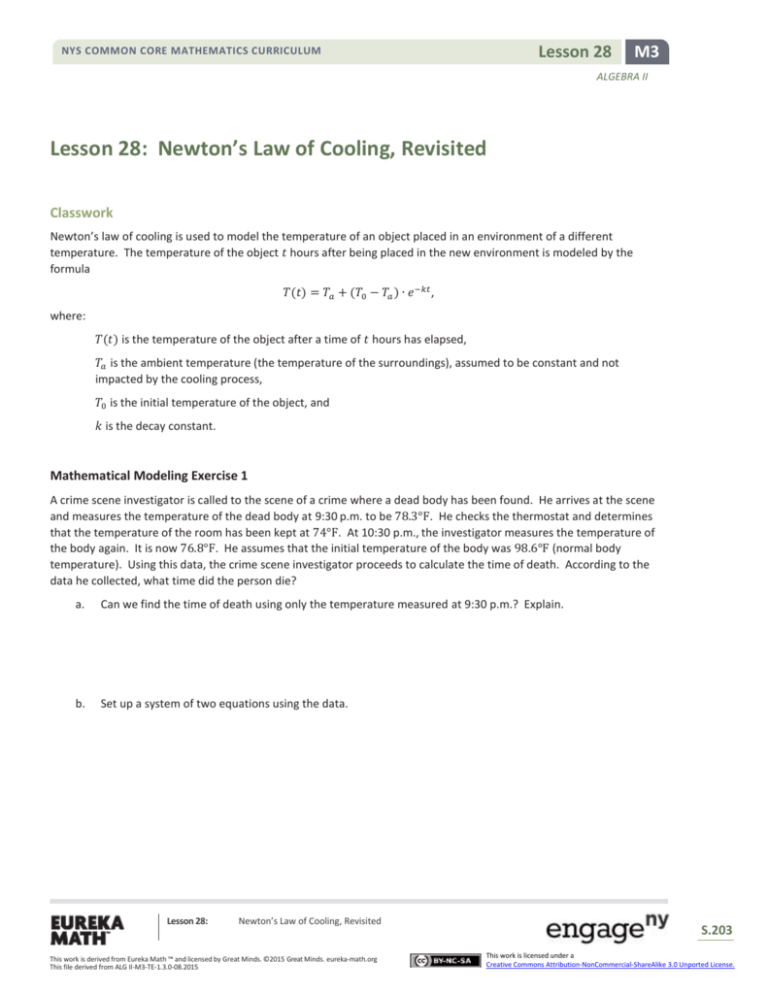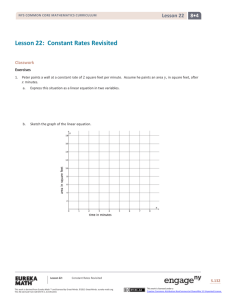Algebra II Module 3, Topic D , Lesson 28: Student Version
advertisement

Lesson 28 NYS COMMON CORE MATHEMATICS CURRICULUM M3 ALGEBRA II Lesson 28: Newton’s Law of Cooling, Revisited Classwork Newton’s law of cooling is used to model the temperature of an object placed in an environment of a different temperature. The temperature of the object 𝑡 hours after being placed in the new environment is modeled by the formula 𝑇(𝑡) = 𝑇𝑎 + (𝑇0 − 𝑇𝑎 ) ∙ 𝑒 −𝑘𝑡 , where: 𝑇(𝑡) is the temperature of the object after a time of 𝑡 hours has elapsed, 𝑇𝑎 is the ambient temperature (the temperature of the surroundings), assumed to be constant and not impacted by the cooling process, 𝑇0 is the initial temperature of the object, and 𝑘 is the decay constant. Mathematical Modeling Exercise 1 A crime scene investigator is called to the scene of a crime where a dead body has been found. He arrives at the scene and measures the temperature of the dead body at 9:30 p.m. to be 78.3°F. He checks the thermostat and determines that the temperature of the room has been kept at 74°F. At 10:30 p.m., the investigator measures the temperature of the body again. It is now 76.8°F. He assumes that the initial temperature of the body was 98.6°F (normal body temperature). Using this data, the crime scene investigator proceeds to calculate the time of death. According to the data he collected, what time did the person die? a. Can we find the time of death using only the temperature measured at 9:30 p.m.? Explain. b. Set up a system of two equations using the data. Lesson 28: Newton’s Law of Cooling, Revisited This work is derived from Eureka Math ™ and licensed by Great Minds. ©2015 Great Minds. eureka-math.org This file derived from ALG II-M3-TE-1.3.0-08.2015 S.203 This work is licensed under a Creative Commons Attribution-NonCommercial-ShareAlike 3.0 Unported License. NYS COMMON CORE MATHEMATICS CURRICULUM Lesson 28 M3 ALGEBRA II d. Find the value of the decay constant, 𝑘. e. What was the time of death? Mathematical Modeling Exercise 2 A pot of tea is heated to 90°C. A cup of the tea is poured into a mug and taken outside where the temperature is 18°C. After 2 minutes, the temperature of the cup of tea is approximately 65°C. a. Determine the value of the decay constant, 𝑘. b. Write a function for the temperature of the tea in the mug, 𝑇, in °C, as a function of time, 𝑡, in minutes. Lesson 28: Newton’s Law of Cooling, Revisited This work is derived from Eureka Math ™ and licensed by Great Minds. ©2015 Great Minds. eureka-math.org This file derived from ALG II-M3-TE-1.3.0-08.2015 S.204 This work is licensed under a Creative Commons Attribution-NonCommercial-ShareAlike 3.0 Unported License. NYS COMMON CORE MATHEMATICS CURRICULUM Lesson 28 M3 ALGEBRA II c. Graph the function 𝑇. d. Use the graph of 𝑇 to describe how the temperature decreases over time. Lesson 28: Newton’s Law of Cooling, Revisited This work is derived from Eureka Math ™ and licensed by Great Minds. ©2015 Great Minds. eureka-math.org This file derived from ALG II-M3-TE-1.3.0-08.2015 S.205 This work is licensed under a Creative Commons Attribution-NonCommercial-ShareAlike 3.0 Unported License. NYS COMMON CORE MATHEMATICS CURRICULUM Lesson 28 M3 ALGEBRA II e. Use properties of exponents to rewrite the temperature function in the form 𝑇(𝑡) = 18 + 72(1 + 𝑟)𝑡 . f. In Lesson 26, we saw that the value of 𝑟 represents the percent change of a quantity that is changing according to an exponential function of the form 𝑓(𝑡) = 𝐴(1 + 𝑟)𝑡 . Describe what 𝑟 represents in the context of the cooling tea. g. As more time elapses, what temperature does the tea approach? Explain using both the context of the problem and the graph of the function 𝑇. Lesson 28: Newton’s Law of Cooling, Revisited This work is derived from Eureka Math ™ and licensed by Great Minds. ©2015 Great Minds. eureka-math.org This file derived from ALG II-M3-TE-1.3.0-08.2015 S.206 This work is licensed under a Creative Commons Attribution-NonCommercial-ShareAlike 3.0 Unported License. Lesson 28 NYS COMMON CORE MATHEMATICS CURRICULUM M3 ALGEBRA II Mathematical Modeling Exercise 3 Two thermometers are sitting in a room that is 22°C. When each thermometer reads 22°C, the thermometers are placed in two different ovens. Data for the temperatures 𝑇1 and 𝑇2 of these thermometers (in °C) 𝑡 minutes after being placed in the oven is provided below. Thermometer 1: 𝒕 (minutes) 0 2 5 8 10 14 𝑻𝟏 (°𝐂) 22 75 132 173 175 176 Thermometer 2: a. Do the table and graph given for each thermometer support the statement that Newton’s law of cooling also applies when the surrounding temperature is warmer? Explain. b. Which thermometer was placed in a hotter oven? Explain. Lesson 28: Newton’s Law of Cooling, Revisited This work is derived from Eureka Math ™ and licensed by Great Minds. ©2015 Great Minds. eureka-math.org This file derived from ALG II-M3-TE-1.3.0-08.2015 S.207 This work is licensed under a Creative Commons Attribution-NonCommercial-ShareAlike 3.0 Unported License. NYS COMMON CORE MATHEMATICS CURRICULUM Lesson 28 M3 ALGEBRA II c. Using a generic decay constant, 𝑘, without finding its value, write an equation for each thermometer expressing the temperature as a function of time. d. How do the equations differ when the surrounding temperature is warmer than the object rather than cooler as in previous examples? e. How do the graphs differ when the surrounding temperature is warmer than the object rather than cooler as in previous examples? Lesson 28: Newton’s Law of Cooling, Revisited This work is derived from Eureka Math ™ and licensed by Great Minds. ©2015 Great Minds. eureka-math.org This file derived from ALG II-M3-TE-1.3.0-08.2015 S.208 This work is licensed under a Creative Commons Attribution-NonCommercial-ShareAlike 3.0 Unported License. Lesson 28 NYS COMMON CORE MATHEMATICS CURRICULUM M3 ALGEBRA II Problem Set 1. Experiments with a covered cup of coffee show that the temperature (in degrees Fahrenheit) of the coffee can be modeled by the following equation: 𝑓(𝑡) = 112𝑒 −0.08𝑡 + 68, where the time is measured in minutes after the coffee was poured into the cup. 2. 3. a. What is the temperature of the coffee at the beginning of the experiment? b. What is the temperature of the room? c. After how many minutes is the temperature of the coffee 140°F? Give your answer to 3 decimal places. d. What is the temperature of the coffee after a few hours have elapsed? e. What is the percent rate of change of the difference between the temperature of the room and the temperature of the coffee? Suppose a frozen package of hamburger meat is removed from a freezer that is set at 0°F and placed in a refrigerator that is set at 38°F. Six hours after being placed in the refrigerator, the temperature of the meat is 12°F. a. Determine the decay constant, 𝑘. b. Write a function for the temperature of the meat, 𝑇 in Fahrenheit, as a function of time, 𝑡 in hours. c. Graph the function 𝑇. d. Describe the transformations required to graph the function 𝑇 beginning with the graph of the natural exponential function 𝑓(𝑡) = 𝑒 𝑡 . e. How long will it take the meat to thaw (reach a temperature above 32°F)? Give answer to three decimal places. f. What is the percent rate of change of the difference between the temperature of the refrigerator and the temperature of the meat? The table below shows the temperature of a pot of soup that was removed from the stove at time 𝑡 = 0. 𝒕 (min) 𝑻 (°C) 0 100 10 34.183 20 22.514 30 20.446 40 20.079 50 20.014 60 20.002 a. What is the initial temperature of the soup? b. What does the ambient temperature (room temperature) appear to be? c. Use the temperature at 𝑡 = 10 minutes to find the decay constant, 𝑘. d. Confirm the value of 𝑘 by using another data point from the table. e. Write a function for the temperature of the soup (in Celsius) as a function of time in minutes. f. Graph the function 𝑇. Lesson 28: Newton’s Law of Cooling, Revisited This work is derived from Eureka Math ™ and licensed by Great Minds. ©2015 Great Minds. eureka-math.org This file derived from ALG II-M3-TE-1.3.0-08.2015 S.209 This work is licensed under a Creative Commons Attribution-NonCommercial-ShareAlike 3.0 Unported License. Lesson 28 NYS COMMON CORE MATHEMATICS CURRICULUM M3 ALGEBRA II 4. Match each verbal description with its correct graph and write a possible equation expressing temperature as a function of time. a. A pot of liquid is heated to a boil and then placed on a counter to cool. b. A frozen dinner is placed in a preheated oven to cook. c. A can of room-temperature soda is placed in a refrigerator. (i) (ii) (iii) Lesson 28: Newton’s Law of Cooling, Revisited This work is derived from Eureka Math ™ and licensed by Great Minds. ©2015 Great Minds. eureka-math.org This file derived from ALG II-M3-TE-1.3.0-08.2015 S.210 This work is licensed under a Creative Commons Attribution-NonCommercial-ShareAlike 3.0 Unported License.









